Categories: Home automation, Autonomous power supply
Number of views: 68791
Comments on the article: 4
How to automate the process of turning on and off the generator
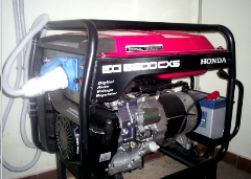 There is no need to tell what is and why an electric generator is needed, everyone already knows so well and quite a lot has been written about this, including on this site. But for those who are "off topic", we explain in a nutshell: PG (generator set) - this is backup power source, which turns on (or turn on) at the moment of loss of the main electricity and connect the necessary load to it (generator) - a house, office, enterprise.
There is no need to tell what is and why an electric generator is needed, everyone already knows so well and quite a lot has been written about this, including on this site. But for those who are "off topic", we explain in a nutshell: PG (generator set) - this is backup power source, which turns on (or turn on) at the moment of loss of the main electricity and connect the necessary load to it (generator) - a house, office, enterprise.
Starting, stopping and connecting the load can be done in two ways - in automatic and manual modes.
In manual mode, when the main (city) electricity disappears, the load is switched to the electric generator using a changeover switch (ideally) or they perform multiple actions with turning off / on the input automaton, which is quite inconvenient ... And if you take into account all the manipulations with the generator, start → warm up → connect load → turn off, so it's generally aerobatics, especially for women;) ...
But why all these extra movements when everything has been invented for a long time? There are special devices called ATS - Automatic Backup Power On. This device monitors the presence of voltage in the network, turns on and turns off the generator, performs all the necessary manipulations with switching loads. And all this without your participation, fully automatic ...
In this short article we will try to talk about how to independently automate the entire process of switching on / off the generator and how to connect the ATS to the generator.
For the normal and correct operation of the “generator-ATS” link, you must understand the algorithm of operation of both the generator and the ATS, namely, all the time parameters of the generator and the ATS, what should be turned on and when.
Work algorithm most ATS approximately the same and built on the same principle. ATS differ mainly in the functionality that they are able to perform.
An approximate algorithm for the operation of ATS.
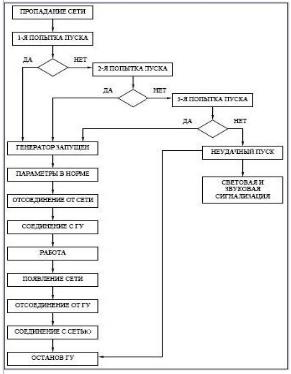
1) Monitoring the voltage of the main network;
2) In the event of a power failure in the city, the backup generator starts up.
The generator starts by the following principle:
a) The ignition relay is switched on;
b) The actuator controls the air damper of the generator;
c) The starter relay is activated;
d) With a successful start, the generator warms up with the subsequent connection of the generator load.
3) When voltage appears in the main network, the load switches from the generator to the city network, followed by a stop of the generator set.
Now you know roughly how does ABP work.
Most generators are arranged approximately the same, so we will not dwell on any particular model.
Further, in order to connect the automation to the generator and carry out the entire process of turning on and off the generator in automatic mode, we need to slightly modernize this very generator. To do this, we need to duplicate the ignition switch.
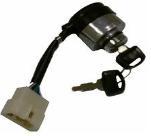 The generator ignition key has three operating positions: “Off”, “On”, “Start”.
The generator ignition key has three operating positions: “Off”, “On”, “Start”.
We disassemble the ignition switch, ring and label the contact groups (wires) we need.
Off position. In this position of the key, the generator does not work. If we ring the ignition lock circuit in this position, we will find 1-2 groups of NC contacts.
On position. In this position of the key, all contacts are BUT.
Position "Start". In this position, the key 1-2 groups of NC.
Having marked the wires we need, we duplicate the contact groups of the ignition switch “Start” and “Off” and connect them to the corresponding connectors of the ABP.
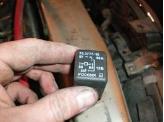 ATTENTION!!! When switching the START generator circuit, be extremely careful. In most AVRs, switching relays are low-power and not designed for high currents. The current for which the contact groups are designed does not exceed 5-10 A (12 V). Therefore, to control the starter, it is necessary to use an intermediate automotive relay.
ATTENTION!!! When switching the START generator circuit, be extremely careful. In most AVRs, switching relays are low-power and not designed for high currents. The current for which the contact groups are designed does not exceed 5-10 A (12 V). Therefore, to control the starter, it is necessary to use an intermediate automotive relay.
Another problem that you may encounter while working is the STOP command of the generator. The fact is that in most generators, two groups of ignition switch contacts are used to stop the generator. In many ABP models, for this purpose, one contact group is provided.
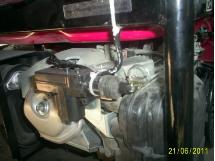 The most suitable way out of this situation is to duplicate the oil pressure sensor. To do this, parallel to the oil sensor we connect NO or NC, depending on the generator model, the ABP contact groups responsible for the generator's “stop” command.
The most suitable way out of this situation is to duplicate the oil pressure sensor. To do this, parallel to the oil sensor we connect NO or NC, depending on the generator model, the ABP contact groups responsible for the generator's “stop” command.
Another important point in the installation process of the system is the connection of the air damper control mechanism.
For this, most often, a retractor (solenoid, activator) is used, used in cars to control the central lock. Connect it to the ATS or, attention, parallel to the starter.
Attention. The article is for informational purposes only. We do not recommend undertaking independent re-equipment of the generator. Trust professionals, and you will be happy.
Sergey Seromashenko
See also on this topic: How to connect the generator to the network at home
See also at e.imadeself.com
:
